Sociological Review: Exploring Key Issues in 'The Indian Act' Book
VerifiedAdded on 2023/06/03
|7
|1232
|236
Report
AI Summary
This report provides a sociological analysis of Bob Joseph's '21 Things You May Not Know about the Indian Act,' examining the historical and ongoing impacts of the Indian Act on indigenous people in Canada. The report delves into specific policies and laws implemented through the Act, such as the band council system, land policies, restrictions on arms and intoxicants, and the banning of cultural ceremonies. It also explores the Act's role in residential learning institutions and its impact on indigenous students' cultural and religious practices. Furthermore, the report discusses the movement to dismantle the Indian Act, highlighting the desire for a more equitable government and the challenges of replacing existing legislation. The conclusion emphasizes the need for a reborn Canada where all people can enjoy equal rights and the importance of self-determination for indigenous communities.
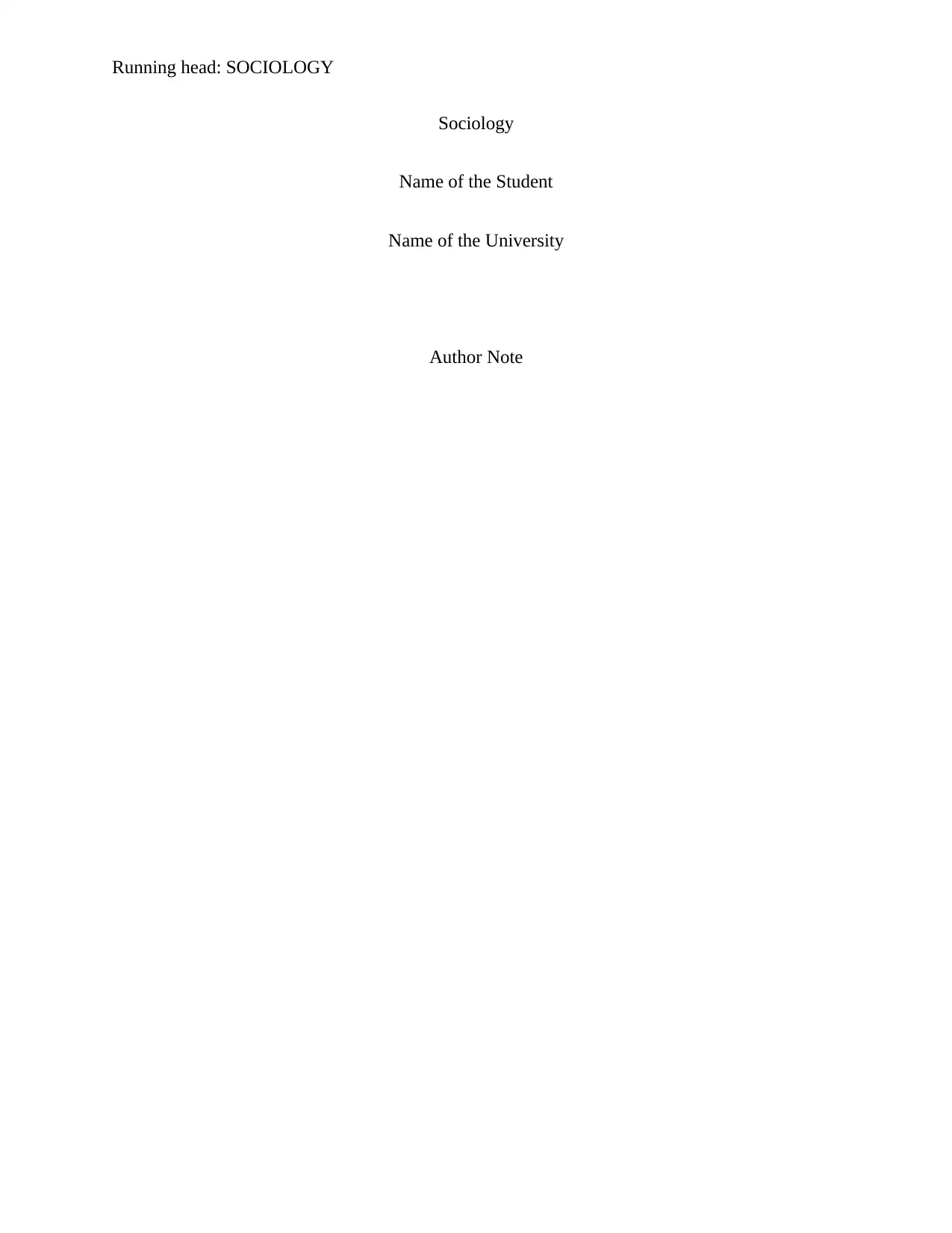
Running head: SOCIOLOGY
Sociology
Name of the Student
Name of the University
Author Note
Sociology
Name of the Student
Name of the University
Author Note
Paraphrase This Document
Need a fresh take? Get an instant paraphrase of this document with our AI Paraphraser
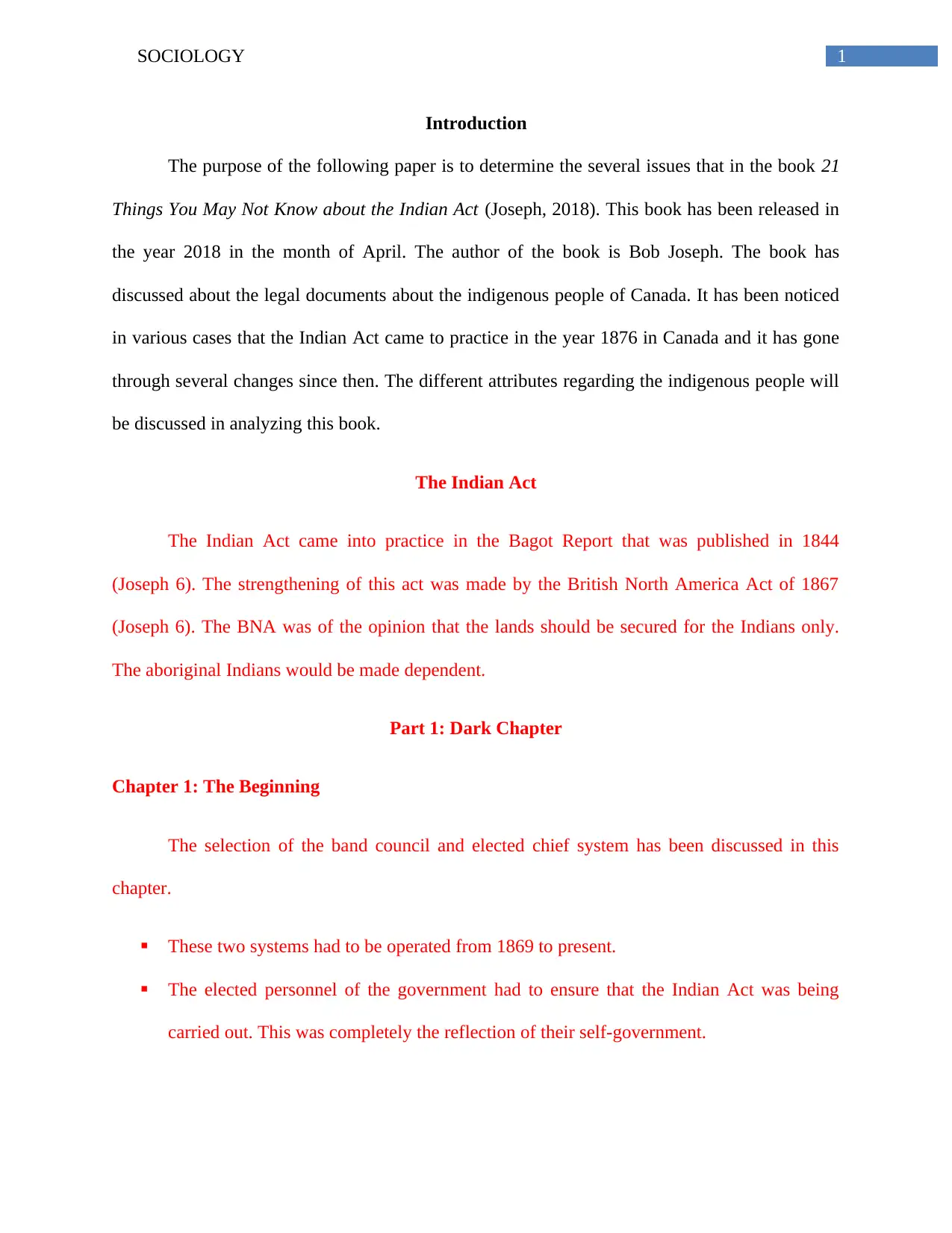
1SOCIOLOGY
Introduction
The purpose of the following paper is to determine the several issues that in the book 21
Things You May Not Know about the Indian Act (Joseph, 2018). This book has been released in
the year 2018 in the month of April. The author of the book is Bob Joseph. The book has
discussed about the legal documents about the indigenous people of Canada. It has been noticed
in various cases that the Indian Act came to practice in the year 1876 in Canada and it has gone
through several changes since then. The different attributes regarding the indigenous people will
be discussed in analyzing this book.
The Indian Act
The Indian Act came into practice in the Bagot Report that was published in 1844
(Joseph 6). The strengthening of this act was made by the British North America Act of 1867
(Joseph 6). The BNA was of the opinion that the lands should be secured for the Indians only.
The aboriginal Indians would be made dependent.
Part 1: Dark Chapter
Chapter 1: The Beginning
The selection of the band council and elected chief system has been discussed in this
chapter.
These two systems had to be operated from 1869 to present.
The elected personnel of the government had to ensure that the Indian Act was being
carried out. This was completely the reflection of their self-government.
Introduction
The purpose of the following paper is to determine the several issues that in the book 21
Things You May Not Know about the Indian Act (Joseph, 2018). This book has been released in
the year 2018 in the month of April. The author of the book is Bob Joseph. The book has
discussed about the legal documents about the indigenous people of Canada. It has been noticed
in various cases that the Indian Act came to practice in the year 1876 in Canada and it has gone
through several changes since then. The different attributes regarding the indigenous people will
be discussed in analyzing this book.
The Indian Act
The Indian Act came into practice in the Bagot Report that was published in 1844
(Joseph 6). The strengthening of this act was made by the British North America Act of 1867
(Joseph 6). The BNA was of the opinion that the lands should be secured for the Indians only.
The aboriginal Indians would be made dependent.
Part 1: Dark Chapter
Chapter 1: The Beginning
The selection of the band council and elected chief system has been discussed in this
chapter.
These two systems had to be operated from 1869 to present.
The elected personnel of the government had to ensure that the Indian Act was being
carried out. This was completely the reflection of their self-government.
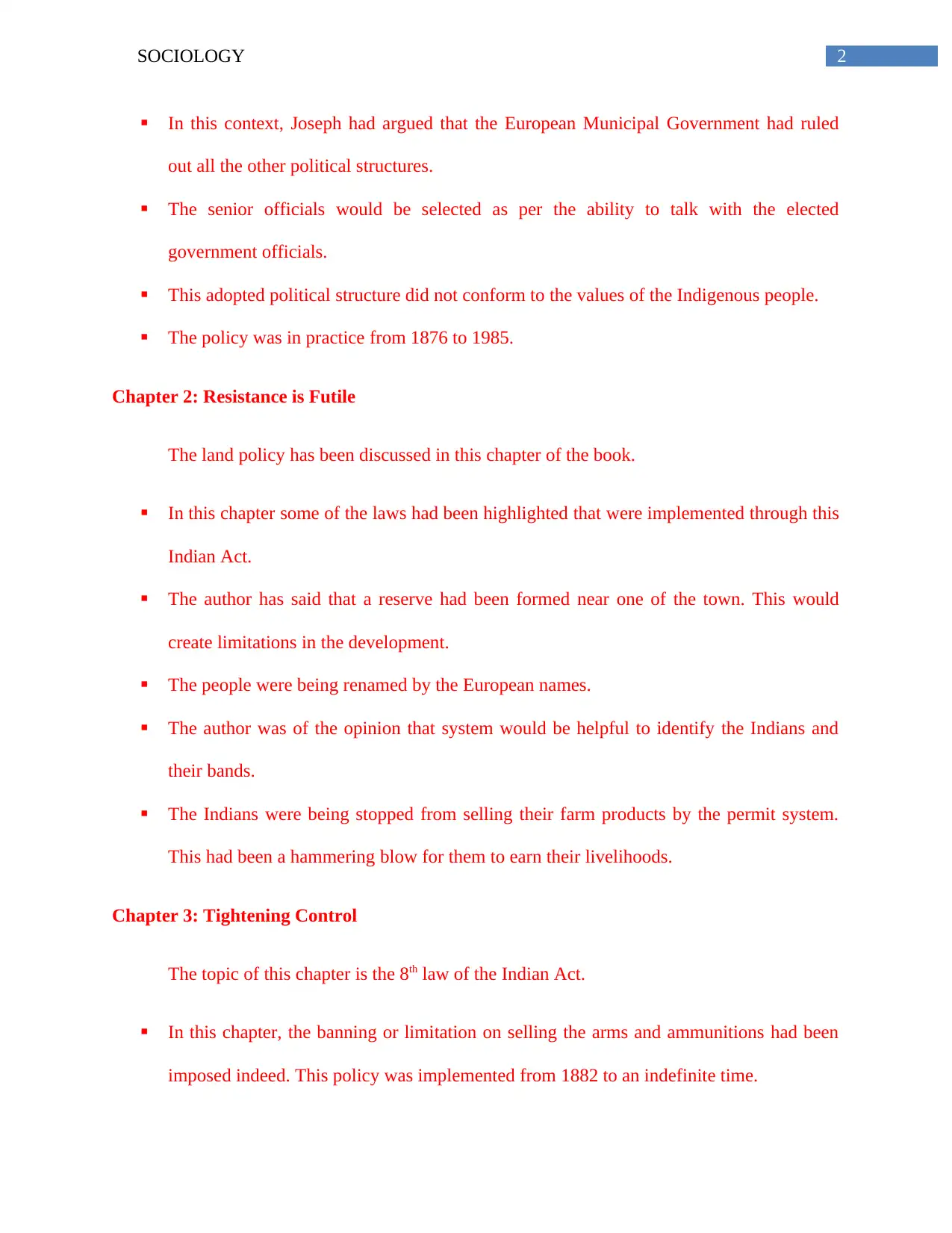
2SOCIOLOGY
In this context, Joseph had argued that the European Municipal Government had ruled
out all the other political structures.
The senior officials would be selected as per the ability to talk with the elected
government officials.
This adopted political structure did not conform to the values of the Indigenous people.
The policy was in practice from 1876 to 1985.
Chapter 2: Resistance is Futile
The land policy has been discussed in this chapter of the book.
In this chapter some of the laws had been highlighted that were implemented through this
Indian Act.
The author has said that a reserve had been formed near one of the town. This would
create limitations in the development.
The people were being renamed by the European names.
The author was of the opinion that system would be helpful to identify the Indians and
their bands.
The Indians were being stopped from selling their farm products by the permit system.
This had been a hammering blow for them to earn their livelihoods.
Chapter 3: Tightening Control
The topic of this chapter is the 8th law of the Indian Act.
In this chapter, the banning or limitation on selling the arms and ammunitions had been
imposed indeed. This policy was implemented from 1882 to an indefinite time.
In this context, Joseph had argued that the European Municipal Government had ruled
out all the other political structures.
The senior officials would be selected as per the ability to talk with the elected
government officials.
This adopted political structure did not conform to the values of the Indigenous people.
The policy was in practice from 1876 to 1985.
Chapter 2: Resistance is Futile
The land policy has been discussed in this chapter of the book.
In this chapter some of the laws had been highlighted that were implemented through this
Indian Act.
The author has said that a reserve had been formed near one of the town. This would
create limitations in the development.
The people were being renamed by the European names.
The author was of the opinion that system would be helpful to identify the Indians and
their bands.
The Indians were being stopped from selling their farm products by the permit system.
This had been a hammering blow for them to earn their livelihoods.
Chapter 3: Tightening Control
The topic of this chapter is the 8th law of the Indian Act.
In this chapter, the banning or limitation on selling the arms and ammunitions had been
imposed indeed. This policy was implemented from 1882 to an indefinite time.
⊘ This is a preview!⊘
Do you want full access?
Subscribe today to unlock all pages.

Trusted by 1+ million students worldwide
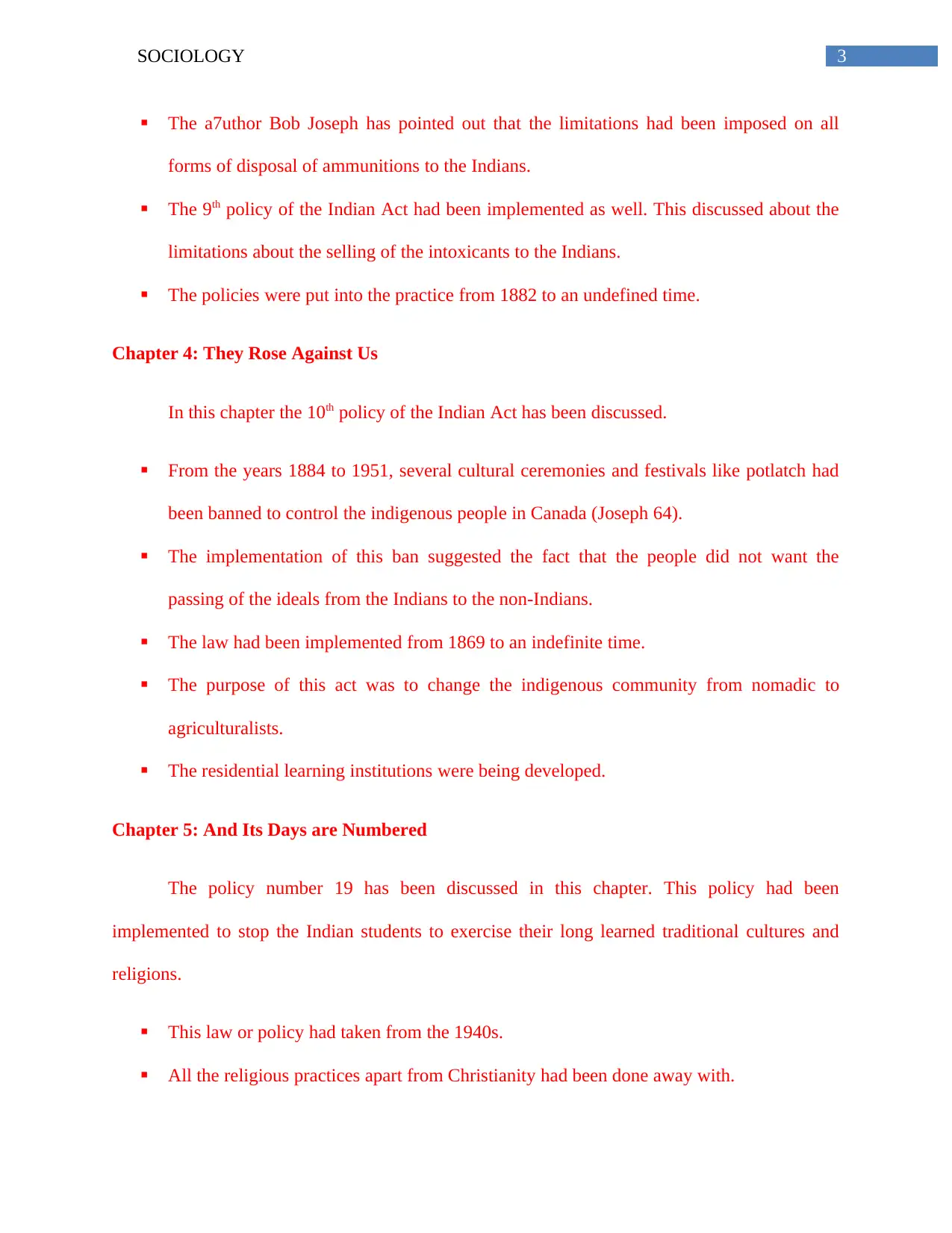
3SOCIOLOGY
The a7uthor Bob Joseph has pointed out that the limitations had been imposed on all
forms of disposal of ammunitions to the Indians.
The 9th policy of the Indian Act had been implemented as well. This discussed about the
limitations about the selling of the intoxicants to the Indians.
The policies were put into the practice from 1882 to an undefined time.
Chapter 4: They Rose Against Us
In this chapter the 10th policy of the Indian Act has been discussed.
From the years 1884 to 1951, several cultural ceremonies and festivals like potlatch had
been banned to control the indigenous people in Canada (Joseph 64).
The implementation of this ban suggested the fact that the people did not want the
passing of the ideals from the Indians to the non-Indians.
The law had been implemented from 1869 to an indefinite time.
The purpose of this act was to change the indigenous community from nomadic to
agriculturalists.
The residential learning institutions were being developed.
Chapter 5: And Its Days are Numbered
The policy number 19 has been discussed in this chapter. This policy had been
implemented to stop the Indian students to exercise their long learned traditional cultures and
religions.
This law or policy had taken from the 1940s.
All the religious practices apart from Christianity had been done away with.
The a7uthor Bob Joseph has pointed out that the limitations had been imposed on all
forms of disposal of ammunitions to the Indians.
The 9th policy of the Indian Act had been implemented as well. This discussed about the
limitations about the selling of the intoxicants to the Indians.
The policies were put into the practice from 1882 to an undefined time.
Chapter 4: They Rose Against Us
In this chapter the 10th policy of the Indian Act has been discussed.
From the years 1884 to 1951, several cultural ceremonies and festivals like potlatch had
been banned to control the indigenous people in Canada (Joseph 64).
The implementation of this ban suggested the fact that the people did not want the
passing of the ideals from the Indians to the non-Indians.
The law had been implemented from 1869 to an indefinite time.
The purpose of this act was to change the indigenous community from nomadic to
agriculturalists.
The residential learning institutions were being developed.
Chapter 5: And Its Days are Numbered
The policy number 19 has been discussed in this chapter. This policy had been
implemented to stop the Indian students to exercise their long learned traditional cultures and
religions.
This law or policy had taken from the 1940s.
All the religious practices apart from Christianity had been done away with.
Paraphrase This Document
Need a fresh take? Get an instant paraphrase of this document with our AI Paraphraser
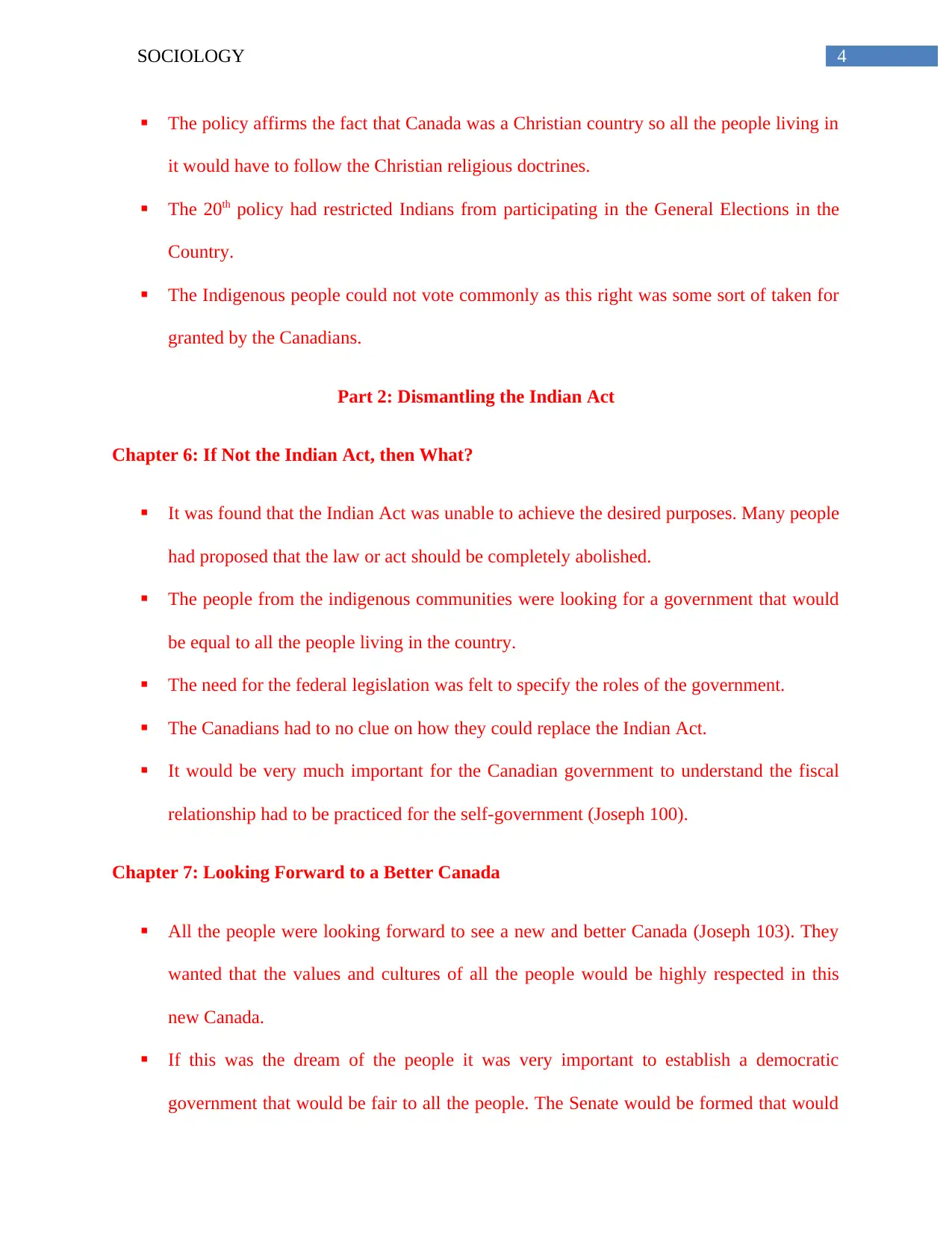
4SOCIOLOGY
The policy affirms the fact that Canada was a Christian country so all the people living in
it would have to follow the Christian religious doctrines.
The 20th policy had restricted Indians from participating in the General Elections in the
Country.
The Indigenous people could not vote commonly as this right was some sort of taken for
granted by the Canadians.
Part 2: Dismantling the Indian Act
Chapter 6: If Not the Indian Act, then What?
It was found that the Indian Act was unable to achieve the desired purposes. Many people
had proposed that the law or act should be completely abolished.
The people from the indigenous communities were looking for a government that would
be equal to all the people living in the country.
The need for the federal legislation was felt to specify the roles of the government.
The Canadians had to no clue on how they could replace the Indian Act.
It would be very much important for the Canadian government to understand the fiscal
relationship had to be practiced for the self-government (Joseph 100).
Chapter 7: Looking Forward to a Better Canada
All the people were looking forward to see a new and better Canada (Joseph 103). They
wanted that the values and cultures of all the people would be highly respected in this
new Canada.
If this was the dream of the people it was very important to establish a democratic
government that would be fair to all the people. The Senate would be formed that would
The policy affirms the fact that Canada was a Christian country so all the people living in
it would have to follow the Christian religious doctrines.
The 20th policy had restricted Indians from participating in the General Elections in the
Country.
The Indigenous people could not vote commonly as this right was some sort of taken for
granted by the Canadians.
Part 2: Dismantling the Indian Act
Chapter 6: If Not the Indian Act, then What?
It was found that the Indian Act was unable to achieve the desired purposes. Many people
had proposed that the law or act should be completely abolished.
The people from the indigenous communities were looking for a government that would
be equal to all the people living in the country.
The need for the federal legislation was felt to specify the roles of the government.
The Canadians had to no clue on how they could replace the Indian Act.
It would be very much important for the Canadian government to understand the fiscal
relationship had to be practiced for the self-government (Joseph 100).
Chapter 7: Looking Forward to a Better Canada
All the people were looking forward to see a new and better Canada (Joseph 103). They
wanted that the values and cultures of all the people would be highly respected in this
new Canada.
If this was the dream of the people it was very important to establish a democratic
government that would be fair to all the people. The Senate would be formed that would
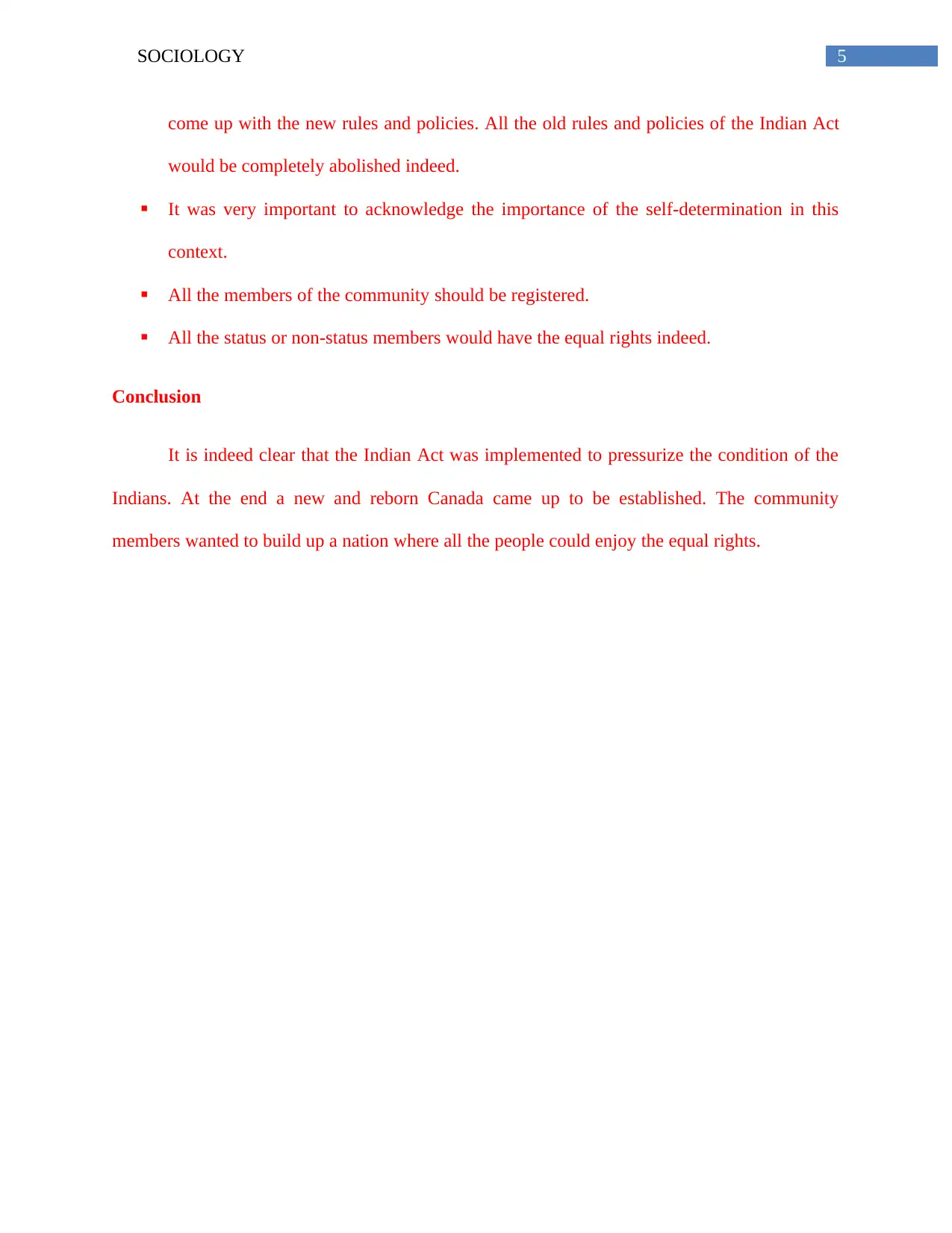
5SOCIOLOGY
come up with the new rules and policies. All the old rules and policies of the Indian Act
would be completely abolished indeed.
It was very important to acknowledge the importance of the self-determination in this
context.
All the members of the community should be registered.
All the status or non-status members would have the equal rights indeed.
Conclusion
It is indeed clear that the Indian Act was implemented to pressurize the condition of the
Indians. At the end a new and reborn Canada came up to be established. The community
members wanted to build up a nation where all the people could enjoy the equal rights.
come up with the new rules and policies. All the old rules and policies of the Indian Act
would be completely abolished indeed.
It was very important to acknowledge the importance of the self-determination in this
context.
All the members of the community should be registered.
All the status or non-status members would have the equal rights indeed.
Conclusion
It is indeed clear that the Indian Act was implemented to pressurize the condition of the
Indians. At the end a new and reborn Canada came up to be established. The community
members wanted to build up a nation where all the people could enjoy the equal rights.
⊘ This is a preview!⊘
Do you want full access?
Subscribe today to unlock all pages.

Trusted by 1+ million students worldwide
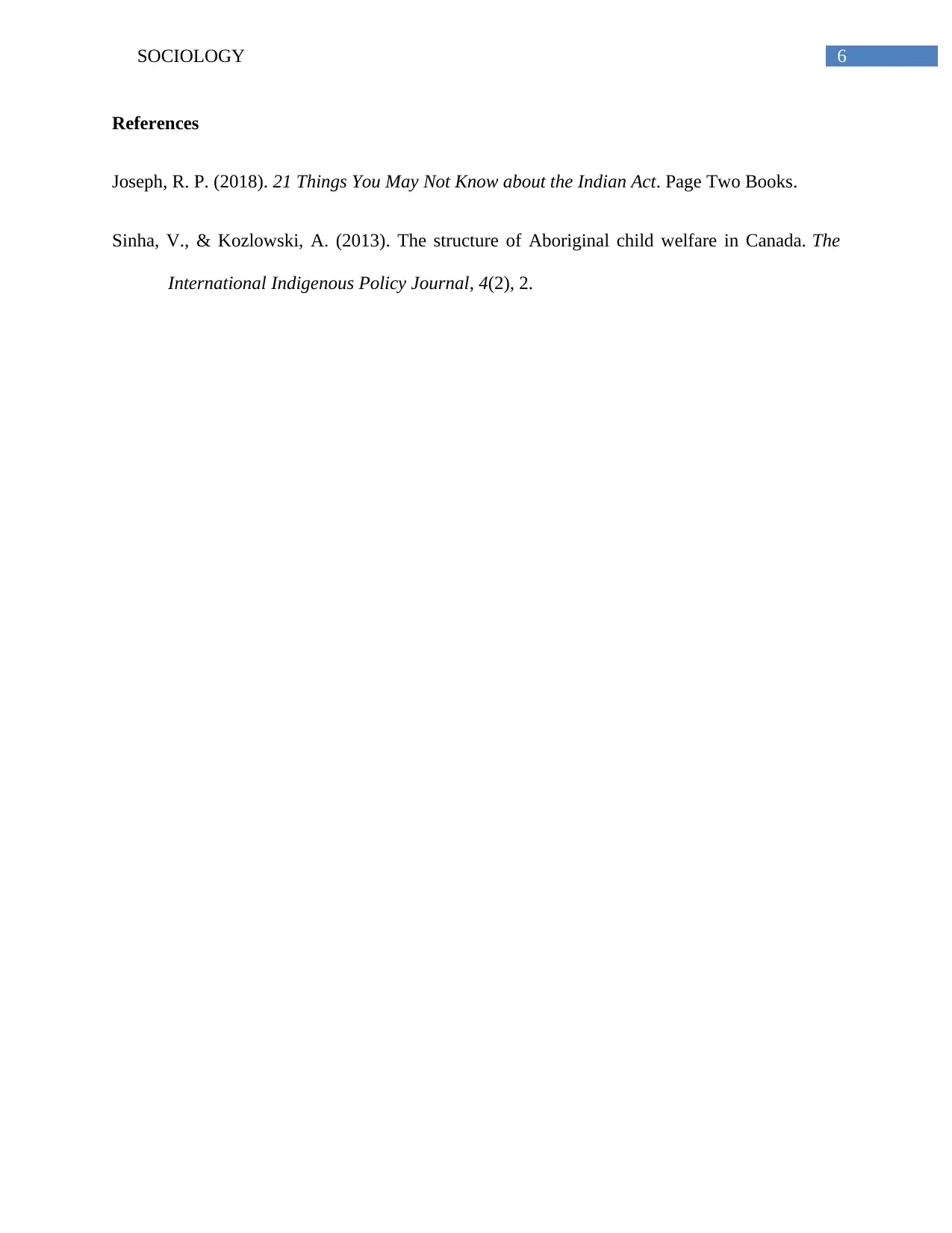
6SOCIOLOGY
References
Joseph, R. P. (2018). 21 Things You May Not Know about the Indian Act. Page Two Books.
Sinha, V., & Kozlowski, A. (2013). The structure of Aboriginal child welfare in Canada. The
International Indigenous Policy Journal, 4(2), 2.
References
Joseph, R. P. (2018). 21 Things You May Not Know about the Indian Act. Page Two Books.
Sinha, V., & Kozlowski, A. (2013). The structure of Aboriginal child welfare in Canada. The
International Indigenous Policy Journal, 4(2), 2.
1 out of 7
Related Documents
Your All-in-One AI-Powered Toolkit for Academic Success.
+13062052269
info@desklib.com
Available 24*7 on WhatsApp / Email
![[object Object]](/_next/static/media/star-bottom.7253800d.svg)
Unlock your academic potential
Copyright © 2020–2025 A2Z Services. All Rights Reserved. Developed and managed by ZUCOL.



